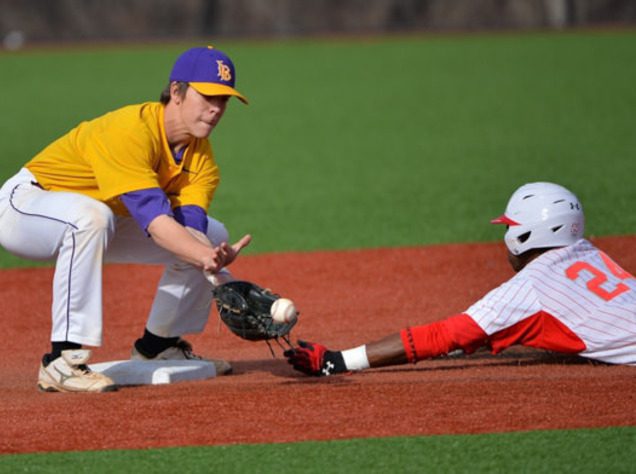Surprisingly, stealing bases is often one of the more overlooked aspects in the game of baseball today. Now that the league is populated and dominated by big sluggers and powerful swingers, the base stealer has often gone by the wayside. However, it can still be an entirely practical way to produce baserunners in scoring position. Every game won’t be won via eight runs and three home runs, so manufacturing runs when you can get them is essential.
While it’s far less glamorous than a multi-base hit or a home run, your odds of generating runs and winning games increases exponentially by moving base runners along. One who is unfamiliar with the aspects of stealing a base might assume speed is the most important factor, however, much of a base runner’s success has already been determined by the time he’s made his jump. Take CoachUp’s training tips with you the next time you’re on first and looking to make a difference for you team.

Reading Isn’t Just For School! A base is stolen off of the pitcher, not the catcher, contrary to popular belief. Typically, this is due to the speed of the pitch as well as the runner’s reaction-time. A runner can determine his own success by getting a good jump or reading the pitcher’s move towards first base. The ability to anticipate a pitcher’s move will result in a much higher success rate, and it’s something that an average runner can utilize to become a base-stealing threat. The key is to approach stealing like a poker player and find a tell in the pitcher’s motion — this will let you know his intention. Here’s how you can read the pitcher:
The Feet
For a right-hander, try studying his back foot, it can often be an indication of his intention towards the plate. Righties are inherently at a disadvantage because they must pitch with their back to first base and from the stretch once runners are on, if they don’t, base runners will steal on them all day. In order for a right-handed pitcher to attempt a pickoff, his right foot, the one touching the rubber, must move first. Once he pulls it off the rubber, he’s not longer announcing his intent to pitch and is able to do whatever he wants with the ball. Once his left foot leaves the ground, thus starting his motion towards the plate, he must continue it. Simply knowing this at all will give you a literal leg up over your pitching adversary.
As for left-handers, it gets a little more complicated. When heading home, a pitcher will dig in his back foot in order to pick up momentum and power with the front foot, so try to focus on the motions. Most lefties will give away their intention in one of two ways: if they lift the toes of their back foot up, they’re likely throwing over. But if they dig it in, they’re going home. Additionally, make sure you pay attention to the left-handed pitcher’s leg throughout the delivery. After picking up their leg, the front toe is often flexed and pointed down when delivering a pitch, but it may be relaxed when picking over to first. It may seem difficult, but experiencing it a few times will help you zone in and notice the tiniest of details.
The Head
Being an effective pitcher has tons do with keeping a consistent rhythm and cadence, so they’ll try to use the same motions and forms as much as possible. So, if anything looks immediately amiss, take caution in your lead. A pitcher who holds the ball in the same deliberate fashion usually intends to go home, so if you can break down their routine, you’ll benefit in the long run.
The First-Step
The next important factor in determining a runner’s jump is the quickness and efficiency of his first step. Two schools of thought exist: the crossover versus the directional step. The crossover step involves driving the left knee across the body and pivoting on your right foot towards second base. In this scenario, your first step would be with the left foot coming across your body. The directional step plants the left leg and drives off of it towards second, while turning your right foot to make that your first step. Both methods are taught at the lower levels of baseball, but the directional step is an overall quicker movement that leads to the runner covering more ground in less amount of time. Of course, complete training calls for repeated practice to gain fluency and quickness in the motion.
The Slide
Sliding is the fastest way to get to a base without risking running past the base. As you’re likely very low to the ground, the throw must be nearly perfect. Most commonly, you’ll see three different slides, which can make the movement unpredictable. Base runners should use these their advantage and dissect in real time which is the best to use.
Feet-First Slide: It’s the most standard slide in your arsenal, but also the safest because it doesn’t put your back, spine, or neck in potential danger. They also call it the pop-up slide because momentum can be used to stand yourself up and continue running if there’s an errant throw or circumstantial change. Sliding on your stomach will likely take a second before you can return to your feet, which might make all the difference between an extra base or an out.
Head-First Slide: This is the fastest slide possible since you’re harnessing all your forward momentum into immediate energy without much speed loss. However, it’s an inherently dangerous play and puts both your head and fingers at risk of serious injury. In fact, many coaches at the youth level have banned it for that very reason.
Hook Slide: Generally speaking, the hook is the same as the feet-first slide except for that you turn to grab the base with your hands instead of with your feet. This allows you to either stay on the inside or outside of the bag more effectively. If you’re on the outside, you’re likely trying to avoid a tag. If you’re on the inside, however, that means you’re trying to break-up a double play by creating contact with the infielder.
(Related: Read about effectively bunting here.)
Huddle Up
Ultimately, stealing bases comes down to much more than just raw speed. At the lowest levels of baseball, that might get you pretty far; but as competition gets stiffer, the pitchers get trickier and the catchers will be more effective. You absolutely must use your own advantages as much as possible. Remember, reading the pitch well, getting a good jump, and using the correct slide will often put you in the best position time and time again. If you’re still having trouble stealing bases or effectively reading the pitcher’s intentions, consider hiring one of CoachUp’s private trainers. Our awesome staff will get you more familiar on the base paths in no time, so what are you waiting for?
Be prepared for the biggest moments by mastering the small ones off the field.
How useful was this post?
Click on a star to rate it!
Average rating 0 / 5. Vote count: 0
No votes so far! Be the first to rate this post.




